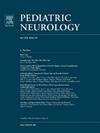首发精神病儿童的自身免疫性脑炎发病率。
IF 3.2
3区 医学
Q2 CLINICAL NEUROLOGY
引用次数: 0
摘要
背景:自身免疫性脑炎(AE)可表现为儿童首发精神病(FEP)。有人提出了一种 FEP 诊断算法,但这种算法如何适用于儿童尚不清楚。我们对FEP诊断算法在儿童FEP患者中的应用进行了评估:方法:将 FEP 算法应用于无其他神经症状的 FEP 儿童回顾性队列:结果:共纳入24名患者,其中5名AE患者(抗N-甲基-d-天冬氨酸受体脑炎)和19名非AE患者(12名原发性精神病患者、2名头痛患者、支原体相关脑炎患者、2019年冠状病毒病后脑炎患者、药物反应伴嗜酸性粒细胞增多和全身症状[DRESS]综合征患者、钴胺素C缺乏症患者和2名未知患者)。一些非 AE 患者(19 人中有 5 人,占 26%)接受了免疫治疗,接受免疫治疗的 5 人中有 1 人(占 20%)症状得到缓解,未接受免疫治疗的 14 人中有 4 人(占 29%)症状得到缓解。FEP算法建议对所有AE患者(5例中的5例=100%)和19例非AE患者中的6例(32%)进行脑脊液(CSF)检测,结果灵敏度为100%(95%置信区间[CI]:100%至100%),特异性为45.5%(95%置信区间:16%至75%),阴性预测值为100%(95%置信区间:100%至100%):结论:FEP可由不同原因引起,包括AE和代谢性疾病。对 FEP 的评估应该广泛,尤其是在没有 CSF 炎症证据的情况下。FEP算法有助于评估哪些患者可从脑脊液检测中获益,应在更大的群体中进行评估。本文章由计算机程序翻译,如有差异,请以英文原文为准。
Rate of Autoimmune Encephalitis in Children With First-Episode Psychosis
Background
Autoimmune encephalitis (AE) can present as first-episode psychosis (FEP) in children. An FEP diagnostic algorithm has been proposed, but how this algorithm applies to children is unknown. We assess the FEP diagnostic algorithm in children with FEP.
Methods
The FEP algorithm was applied to a retrospective cohort of children with FEP without other neurological symptoms.
Results
Twenty-four patients were included, with five AE (anti-N-methyl-d-aspartate receptor encephalitis) and 19 non-AE patients (12 primary psychiatric, two headaches, mycoplasma-related encephalitis, post–coronavirus disease 2019 encephalitis, drug reaction with eosinophilia and systemic symptoms [DRESS] syndrome, cobalamin C deficiency, and two unknown). Some non-AE patients (five of 19 = 26%) received immunotherapies, with symptom resolution in one of five (20%) with immunotherapy and in four of 14 (29%) without immunotherapy. The FEP algorithm recommended cerebrospinal fluid (CSF) testing in all (five of five = 100%) patients with AE and in six of 19 (32%) non-AE patients, resulting in 100% sensitivity (95% confidence interval [CI]: 100% to 100%) and 45.5% specificity (95% CI: 16% to 75%), with a negative predictive value of 100% (95% CI: 100% to 100%).
Conclusions
FEP can occur in children from different causes, including AE and metabolic conditions. Evaluation of FEP should be broad, especially without CSF evidence of inflammation. The FEP algorithm is useful to assess patients who would benefit from CSF testing and should be assessed in larger cohorts.
求助全文
通过发布文献求助,成功后即可免费获取论文全文。
去求助
来源期刊

Pediatric neurology
医学-临床神经学
CiteScore
4.80
自引率
2.60%
发文量
176
审稿时长
78 days
期刊介绍:
Pediatric Neurology publishes timely peer-reviewed clinical and research articles covering all aspects of the developing nervous system.
Pediatric Neurology features up-to-the-minute publication of the latest advances in the diagnosis, management, and treatment of pediatric neurologic disorders. The journal''s editor, E. Steve Roach, in conjunction with the team of Associate Editors, heads an internationally recognized editorial board, ensuring the most authoritative and extensive coverage of the field. Among the topics covered are: epilepsy, mitochondrial diseases, congenital malformations, chromosomopathies, peripheral neuropathies, perinatal and childhood stroke, cerebral palsy, as well as other diseases affecting the developing nervous system.
 求助内容:
求助内容: 应助结果提醒方式:
应助结果提醒方式:


